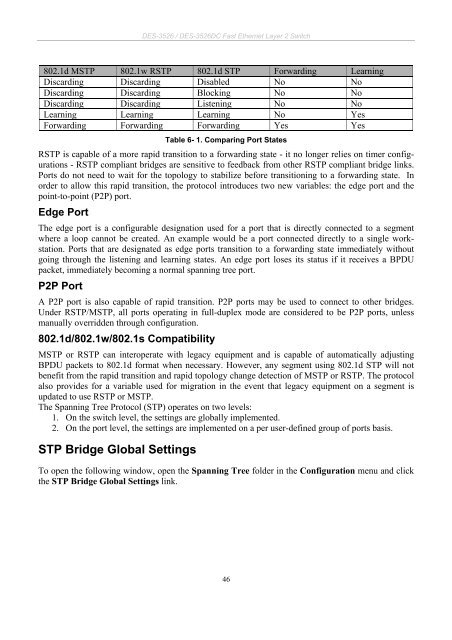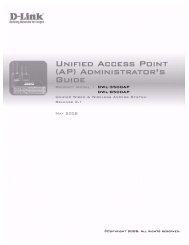Product Manual
Product Manual
Product Manual
You also want an ePaper? Increase the reach of your titles
YUMPU automatically turns print PDFs into web optimized ePapers that Google loves.
DES-3526 / DES-3526DC Fast Ethernet Layer 2 Switch<br />
802.1d MSTP 802.1w RSTP 802.1d STP Forwarding Learning<br />
Discarding Discarding Disabled No No<br />
Discarding Discarding Blocking No No<br />
Discarding Discarding Listening No No<br />
Learning Learning Learning No Yes<br />
Forwarding Forwarding Forwarding Yes Yes<br />
Table 6- 1. Comparing Port States<br />
RSTP is capable of a more rapid transition to a forwarding state - it no longer relies on timer configurations<br />
- RSTP compliant bridges are sensitive to feedback from other RSTP compliant bridge links.<br />
Ports do not need to wait for the topology to stabilize before transitioning to a forwarding state. In<br />
order to allow this rapid transition, the protocol introduces two new variables: the edge port and the<br />
point-to-point (P2P) port.<br />
Edge Port<br />
The edge port is a configurable designation used for a port that is directly connected to a segment<br />
where a loop cannot be created. An example would be a port connected directly to a single workstation.<br />
Ports that are designated as edge ports transition to a forwarding state immediately without<br />
going through the listening and learning states. An edge port loses its status if it receives a BPDU<br />
packet, immediately becoming a normal spanning tree port.<br />
P2P Port<br />
A P2P port is also capable of rapid transition. P2P ports may be used to connect to other bridges.<br />
Under RSTP/MSTP, all ports operating in full-duplex mode are considered to be P2P ports, unless<br />
manually overridden through configuration.<br />
802.1d/802.1w/802.1s Compatibility<br />
MSTP or RSTP can interoperate with legacy equipment and is capable of automatically adjusting<br />
BPDU packets to 802.1d format when necessary. However, any segment using 802.1d STP will not<br />
benefit from the rapid transition and rapid topology change detection of MSTP or RSTP. The protocol<br />
also provides for a variable used for migration in the event that legacy equipment on a segment is<br />
updated to use RSTP or MSTP.<br />
The Spanning Tree Protocol (STP) operates on two levels:<br />
1. On the switch level, the settings are globally implemented.<br />
2. On the port level, the settings are implemented on a per user-defined group of ports basis.<br />
STP Bridge Global Settings<br />
To open the following window, open the Spanning Tree folder in the Configuration menu and click<br />
the STP Bridge Global Settings link.<br />
46

















